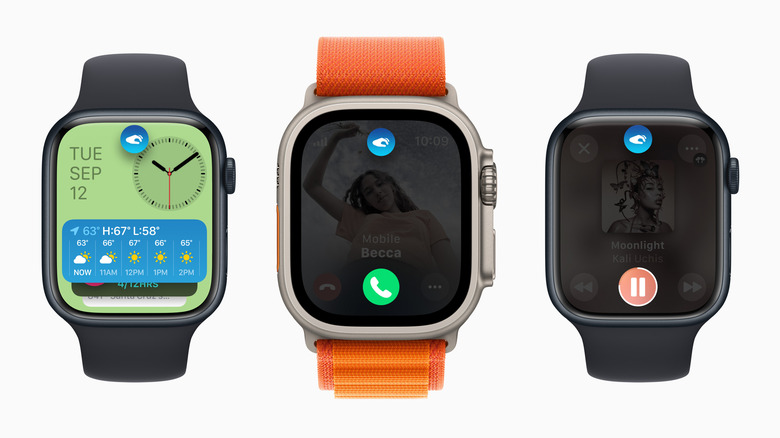Pros And Cons Of The New Apple Watch Double-Tap Feature
The Double Tap motion was added to watchOS 10.1 in October 2023, compatible with Apple Watch Ultra 2 as well as the Series 9 model. Users can utilize the gesture to start and stop any audio playback they have running, begin and end calls, respond to notifications, and use a range of their device's other important functions.
This thumb-and-forefinger feature is made possible by the S9 processor, which also gives users the capacity to consult Siri without the need for an internet connection. Potential users may be wondering, then, just how useful this new gesture will be. After all, our devices tend to be full of features that range from useful on a daily basis to never touched.
Whether you'll be constantly double-tapping in this new way is very much a personal matter. What we can do, though, is take a closer look at the functionality's pros and cons to see whether it's something that will be worth enabling for you.
The pros of the Double Tap gesture
One of the primary advantages of the double-tap gesture is that it doesn't require physically tapping the screen. As such, users won't need to reach for their watch (which could be particularly tricky depending on what they're holding/wearing at the time) to interact with it. It's one of those convenient features Apple Watch users may not even know they have access to.
The hands-free appeal will be clear to those who struggle with gloves (often the bane of touchscreens everywhere) and device functionality in cold weather. The Double Tap function can also be adjusted to better suit the user's preferences, enhancing its versatility via its menu within the Gestures settings. Double Tap can be set to either Select a specific widget from the Smart Stack or Advance through them; and for audio playback, the settings can be adjusted so a Double Tap will skip rather than pause or continue your audio.
It's perhaps in the simplest of Apple Watch functions that Double Tap displays its utility the most. Smart devices enjoy buzzing with a wide range of notifications, and the ability to "swipe away" such distractions with a simple gesture, potentially even mid-sentence (whether typed or spoken), is very nice indeed.
Double Tap is an addition that may well prove very convenient for users in a range of such situations. Nevertheless, there are some important shortcomings of the feature to consider, too.
The cons of the Double Tap gesture
From smartphones to ATMs and vending machines, the habit of tapping on devices is a difficult one to break. It's a part of muscle memory. As a result, Double Tap may go unutilized by those unwilling to make the change or who simply forget they have the new option enabled.
Users of AssistiveTouch, meanwhile, will find that Double Tap cannot be used at the same time as the former. AssistiveTouch has a far wider range of gesture-based functions, allowing for comprehensive control of the device and its Digital Crown, and the contrast is clear. It's meant as an invaluable accessibility aid, while Double Tap is intended simply for convenience in situations that the user may never find themselves in.
Those who have accidentally made calls by leaning on their phones should be aware of the dangers of inadvertent gesturing, too. An Apple Newsroom post explains that Double Tap works through the new Neural Engine and an algorithm that "detects the unique signature of tiny wrist movements and changes in blood flow when the index finger and thumb perform a double tap." If users find it too sensitive to these movements, an animated conversation could become a cacophony of unintended Double Taps.
Ultimately, whether Double Tap is a must-use, a feature to activate for niche use cases, or something to never enable is for the individual user to decide. Regardless, more optional functionality is rarely a bad thing.


